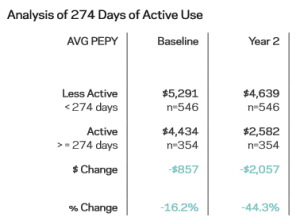“Springbuk does not certify the information, nor does it guarantee the accuracy and completeness of such information.”
Bobby, We Hardly Knew Ye: Bob Merberg leaving Paychex
Bob Merberg is moving on from Paychex, and in a lengthy (!) podcast with Jen Arnold, offers his “greatest hits” of the many ways in which his mind has been changed (“flip flops”) during his ten years in that position, and some advice for the future.
By way of background, Bob’s IntEWn blog has been a refreshing voice from the wellness trenches. Bob is quite literally the only corporate wellness manager willing to risk the wrath of various internal powers that be in order to report what really happens in wellness. By contrast, most other blogs are written by various outsiders reporting what they think should happen (or they think is happening) in wellness.
Here are the highlights of what he has learned (“flip flops”) in the decade he has been doing this:
- HRAs have very little value
- Screenings have even less value than HRAs (“I was railing against screenings a really long time ago”)
- Incentives have even less value than screenings (“the hallmark of a sh**ty program”) and Bob has de-emphasized them. We have a more nuanced view.
- CEO support is helpful is wellness even if they don’t walk 5000 steps. There are things only CEOs can do (such as employee-friendly building design).
- Culture is very difficult to change, and employees generally hate culture change for many good reasons…but it is much easier to found the company with the right culture to begin with (like we did at Quizzify). “Where are the success stories in culture change?”
- Outcomes-based incentives are “shameful,” and are little more than a cost-shift to employees who can least afford it. (“Given all of us a bad name”)
Here is the good news, his view of Total Worker Health (as described by the CDC), which is influenced by more basic factors than broccoli consumption:
- Living wages and other financial assistance, like 401K
- Work schedules and too much overtime, a huge source of stress, should be managed
- Things like quotas and goals set too high to meet (like at Wells Fargo) that create incredible stress. This Wells Fargo story alone merits the entire podcast. Ironically, they have a wellness program that includes stress management. “You as an employer are creating the conditions of stress.”
- The employer should start with creating healthier jobs, rather than helping employees cope with unhealthy jobs.
- It’s not about behavior and behavior change — it’s about the workplace itself.
I’ll leave the rest to you. Don’t want to steal his thunder.
We wish Bob the best in his new career as a consultant and look forward to working together.
Just sit right back and you’ll hear a tale, a tale of wellness incentives
It turns out that the “answer” to the question of whether and when wellness incentives work can be found in the theme song to Gilligan’s Island. Who would have guessed?
As is the new TSW policy, when we don’t “profile” various perps in the wellness industry by name, we do our postings on the Corporate Wellness magazine website. So you’ll have to visit there to see the details.
Springbuk wants employees to go to the bathroom
Oh, so lovely sittin’
Abso-bloomin’-lutely still
I would never budge till spring
Crept over me window sill
–Eliza Doolittle
Springbuk has found the key to dramatic reduction in healthcare spending: getting out of bed. It doesn’t matter whether it’s to eat, find the remote, or, of course, pee. Just do something, anything, other than lie in bed all day — and you count as an “active” person who saves a ton of money, as compared to people who never get out of bed. Yes, Springbuk classifies you as “active” if you take at least 100 steps a day:
My question, for now, is not about how all this money was allegedly saved. Rather, my question for now is: how did these “less active” people — a huge chunk of the total population studied –manage to take fewer than 100 steps a day in the first place? Consider this random floor plan:
Now overlay the steps you take just in order to get up in the morning. A one-way trip to the bathroom and then to the breakfast nook appears to require about 20 steps. You haven’t even had your coffee yet and already you are a fifth of the way to your daily goal.
Speaking of coffee, add in a few more trips to the bathroom and <voila> you’ve reached your steps goal. Conclusion: it is impossible not to walk 100 steps a day, unless you want to starve to death, burst your bladder, or work at Spacely’s Sprockets. We wouldn’t recommend any of those three, especially the last, a very high-stress environment.
As a sidebar, I would note that George Jetson ironically has a lower BMI than Fred Flintstone, thus showing that taking more than 100 steps a day doesn’t reduce weight. Nor does a paleo diet, apparently. (Portion sizes might have something to do with it.) On the other hand, Fred can power his own car, thus showing the value of maintaining health at any size.
The Economics of Getting out of Bed
And needless to say, Springbuk provides some very compelling economics about the cost savings impact of getting out of bed. 100 steps a day for only 274 days a year (meaning you can take a well-deserved breather on weekends, holidays, vacation days and Beethoven’s birthday) generates a dramatic 28% reduction in costs. Wow! Who knew that peeing, eating, and looking for the remote (try your fridge or dresser drawers) could be so beneficial to your health?
Springbuk has additional bad news and good news.
The bad news is that taking 100 steps a day for more than 182 days (as opposed to more than 274 days) makes only a 3% differential impact on health spending, vs. taking 100 steps a day for less than 182 days. Still, there is some good news, which is that staying in bed for half the year also generates a huge reduction in costs, 31% to be exact.
Springbuk didn’t mention this, but the only way both these findings could be consistent would be that people –we will call them “semi-active” — who take 100 steps on more than 182 days but fewer than 274 days must have ridiculously high, off-the-charts healthcare spending and presumably morbidity. Apparently, moving those semi-active people between “less active” and “active” swings overall healthcare spending for the entire population by 25%.
The implication, as any exercise physiologist would tell you, is that starting in January, you need to track the number of days on which you take 100 steps. If you get to 181 such days by late summer, but don’t think you can make it to 274 days by the end of the year, then your best bet, statistically speaking, is to stay in bed until the ball drops in Times Square. Your bosses will love you for it, because you’ll be saving them 31%.
Naturally, Springbuk’s findings contradict all the other findings on wearables showing trivial changes in activity due to wearables after a short burst of interest. These trivial changes predictable show only trivial improvements in health and costs.
And someone should tell the Einsteins at Springbuk what anyone with a triple-digit IQ could intuit and what every other study shows: that a typical American takes many times more than 100 steps a day. 6886 steps per day, according to one study. So Springbuk’s study is wrong, making them eligible for a Koop Award.
Springbuk’s analysis may be wrong for another reason too: It does not account for the health hazards of taking too many steps. (Yes, you need to click through for the punchline.)
An accurate line in this report
I can’t believe I missed this, but Pete Aren didn’t, and pointed it out on linkedin. There is indeed one accurate line in their report, buried in the footnotes:
Testing employee prostates is the new black.
After considerable deliberation by our management team and Board of Directors, and after putting it to a vote of the shareholders after consulting our bylaws, we have adopted a new policy of moving all posts not actually calling out vendors by name to The Corporate Health and Wellness Association website. The only problem with that website for this article is that no article on prostate testing is complete without mentioning Interactive Health and their policy of testing your prostate whether you like it or not, or even whether you still have one or not.
So visit our follow-up prostate cancer post there. (The initial prostate article can be found here.)
Coming soon on this site: Is Interactive Health the new Wellsteps?














